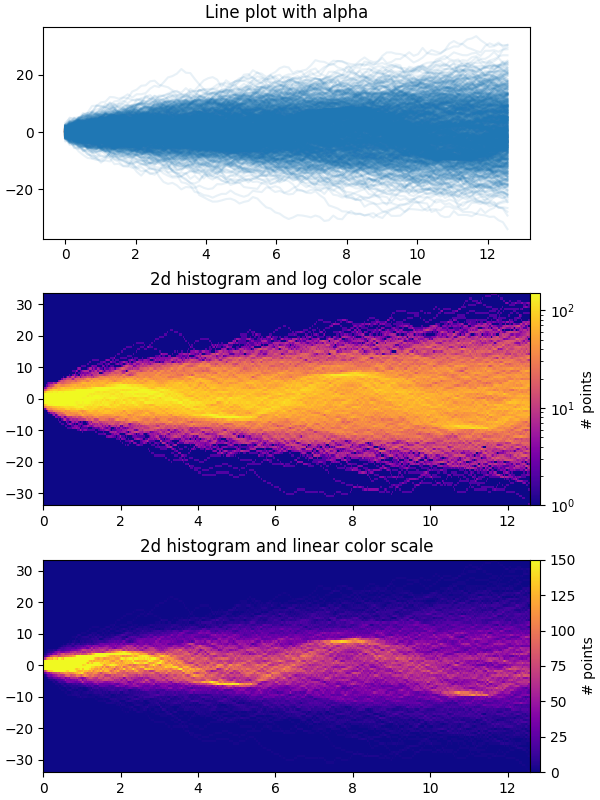ノート
完全なサンプルコードをダウンロードするには、ここをクリックしてください
時系列ヒストグラム#
この例では、すぐには明らかにならない隠れた部分構造やパターンを潜在的に明らかにする方法で、多数の時系列を効率的に視覚化し、それらを視覚的に魅力的な方法で表示する方法を示します。
この例では、多数のランダム ウォーク「ノイズ/バックグラウンド」シリーズの下に埋もれている複数の正弦波「シグナル」シリーズを生成します。標準偏差が σ の偏りのないガウス ランダム ウォークの場合、n ステップ後の原点からの RMS 偏差は σ*sqrt(n) です。したがって、正弦波をランダム ウォークと同じスケールで表示し続けるために、振幅をランダム ウォーク RMS でスケーリングします。さらにphi
、サインを左右にシフトするための小さなランダム オフセットと、個々のデータ ポイントを上下にシフトする追加のランダム ノイズを導入して、信号をもう少し「リアル」にします (完全なサインは期待できません)。波がデータに表示されます)。
plt.plot最初のプロットは、複数の時系列をと の小さな値で
重ね合わせることにより、複数の時系列を視覚化する一般的な方法を示していますalpha。2 番目と 3 番目のプロットは、 と を使用して、オプションでデータ ポイント間の補間を使用して、データを 2 次元ヒストグラムとして再解釈する方法を示してい
np.histogram2dますplt.pcolormesh。
from copy import copy
import time
import numpy as np
import numpy.matlib
import matplotlib.pyplot as plt
from matplotlib.colors import LogNorm
fig, axes = plt.subplots(nrows=3, figsize=(6, 8), constrained_layout=True)
# Make some data; a 1D random walk + small fraction of sine waves
num_series = 1000
num_points = 100
SNR = 0.10 # Signal to Noise Ratio
x = np.linspace(0, 4 * np.pi, num_points)
# Generate unbiased Gaussian random walks
Y = np.cumsum(np.random.randn(num_series, num_points), axis=-1)
# Generate sinusoidal signals
num_signal = int(round(SNR * num_series))
phi = (np.pi / 8) * np.random.randn(num_signal, 1) # small random offset
Y[-num_signal:] = (
np.sqrt(np.arange(num_points))[None, :] # random walk RMS scaling factor
* (np.sin(x[None, :] - phi)
+ 0.05 * np.random.randn(num_signal, num_points)) # small random noise
)
# Plot series using `plot` and a small value of `alpha`. With this view it is
# very difficult to observe the sinusoidal behavior because of how many
# overlapping series there are. It also takes a bit of time to run because so
# many individual artists need to be generated.
tic = time.time()
axes[0].plot(x, Y.T, color="C0", alpha=0.1)
toc = time.time()
axes[0].set_title("Line plot with alpha")
print(f"{toc-tic:.3f} sec. elapsed")
# Now we will convert the multiple time series into a histogram. Not only will
# the hidden signal be more visible, but it is also a much quicker procedure.
tic = time.time()
# Linearly interpolate between the points in each time series
num_fine = 800
x_fine = np.linspace(x.min(), x.max(), num_fine)
y_fine = np.empty((num_series, num_fine), dtype=float)
for i in range(num_series):
y_fine[i, :] = np.interp(x_fine, x, Y[i, :])
y_fine = y_fine.flatten()
x_fine = np.matlib.repmat(x_fine, num_series, 1).flatten()
# Plot (x, y) points in 2d histogram with log colorscale
# It is pretty evident that there is some kind of structure under the noise
# You can tune vmax to make signal more visible
cmap = copy(plt.cm.plasma)
cmap.set_bad(cmap(0))
h, xedges, yedges = np.histogram2d(x_fine, y_fine, bins=[400, 100])
pcm = axes[1].pcolormesh(xedges, yedges, h.T, cmap=cmap,
norm=LogNorm(vmax=1.5e2), rasterized=True)
fig.colorbar(pcm, ax=axes[1], label="# points", pad=0)
axes[1].set_title("2d histogram and log color scale")
# Same data but on linear color scale
pcm = axes[2].pcolormesh(xedges, yedges, h.T, cmap=cmap,
vmax=1.5e2, rasterized=True)
fig.colorbar(pcm, ax=axes[2], label="# points", pad=0)
axes[2].set_title("2d histogram and linear color scale")
toc = time.time()
print(f"{toc-tic:.3f} sec. elapsed")
plt.show()

0.219 sec. elapsed
0.071 sec. elapsed
参考文献
この例では、次の関数、メソッド、クラス、およびモジュールの使用が示されています。
スクリプトの合計実行時間: ( 0 分 2.659 秒)